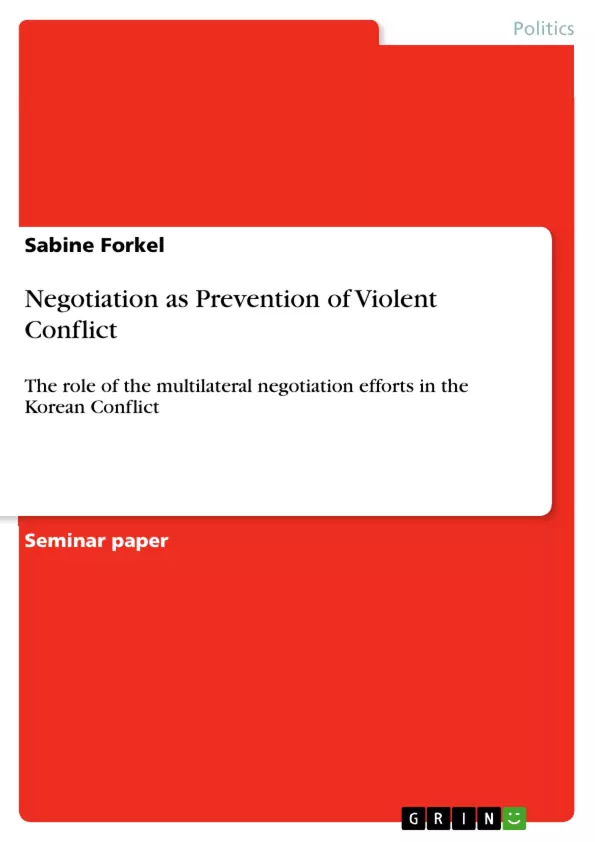At the end of the Cold War, North Korea changed its military interventions into an approach to negotiations in order to use diplomatic talks to advance its political and propaganda aims. Since then there has been a long period of mistrust and provocation between the involved countries, notably North and South Korea, the USA, China and Japan.
After the nuclear weapons test in North Korea in 2006 it has become even more important to rethink the security policy concept of the whole region. The most important way to prevent an outbreak of the “cold war” to a “hot war” is to keep the
negotiation process going on.
To find out the main interests of the parties and negotiate between them, China initiated the so-called Six-party talks, which have started in 2003 and since then had to cope with several difficulties. They aim to find a peaceful resolution to the security
concerns of the participating states. The most important issue is the North Korean nuclear weapons program that is provoking the stability of the whole region. For that reason are the six-party talks “a matter of extreme importance” to develop a world nuclear security (Lee 2004: 120).
After North Korea made public that it has built a nuclear weapon one of the main risks is that South Korea, Japan and maybe also Taiwan could also build one which would raise the risk for a military escalation of the conflict. Another dangerous threat is North Koreas export of nuclear weapons into countries that are part of America’s so-called “axis of evil”.
In December 1991 North Korea agreed to sign two documents with South Korea. The first was an agreement on reconciliation, non-aggression, exchanges and cooperation; the other was the Joint Declaration on the Denuclearization of the Korean Peninsula. Thereafter the two Koreas entered a difficult negotiation to implement a nuclear inspection regime, which broke down without agreement. [...]
Inhaltsverzeichnis (Table of Contents)
- 1. INTRODUCTION
- 2. HISTORICAL BACKGROUND
- 3. THE KOREAN CONFLICT
- 3.1 WHAT IS IT ABOUT?
- 3.1.1 The struggle about the absolute power
- 3.1.2 North Korea's nuclear programme
- 3.2 MAIN CONFLICT PARTIES AND THEIR RELATIONS
- 3.2.1 North Korea, China and Russia
- 3.2.2 South Korea, USA and Japan
- 4. NEGOTIATION EFFORTS IN THE KOREAN CONFLICT
- 4.1 MEDIATION EFFORTS OF JIMMY CARTER AND THE AGREED FRAMEWORK
- 4.2 THE KOREAN PENINSULA ENERGY DEVELOPMENT ORGANIZATION (KEDO)
- 4.3 THE SIX-PARTY TALKS
- 4.3.1 The parties and their interests
- 4.3.2 Outcomes
- 4.3.3 North Korea's strategy within six-party talks
- 5. RESULTS
- 6. REFERENTS
Zielsetzung und Themenschwerpunkte (Objectives and Key Themes)
This paper aims to provide a comprehensive overview of the negotiation efforts undertaken to address the Korean Conflict, focusing on the six-party talks and their significance in preventing an escalation of the conflict. It examines the historical context of the conflict, analyzes the interests and relations of the main conflict parties, and explores the key negotiation processes and outcomes.
- The historical background of the Korean Conflict and the complex relations between the conflict parties.
- The motivations and interests of the main conflict parties, including North and South Korea, the USA, China, and Japan.
- The different phases and strategies employed in the negotiation process, particularly the six-party talks.
- The impact of North Korea's nuclear program on the security of the region and the challenges it poses to peaceful resolution.
- The importance of multilateral negotiations as a tool to prevent an escalation of the conflict and promote stability in the Korean Peninsula.
Zusammenfassung der Kapitel (Chapter Summaries)
- Chapter 1: Introduction: This chapter introduces the historical background of the Korean Conflict, emphasizing the shift in North Korea's approach from military interventions to negotiations. It highlights the increasing importance of maintaining a dialogue to prevent the conflict from escalating from a "cold war" to a "hot war". The chapter also introduces the six-party talks as a key initiative aimed at finding a peaceful solution to the security concerns of the participating states, particularly regarding North Korea's nuclear program.
- Chapter 2: Historical Background: This chapter explores the historical roots of the Korean Conflict, focusing on the relationship between Korea and Japan. It describes the Japanese domination of Korea, the economic exploitation, and the widespread resistance that led to mass demonstrations in 1919. It also emphasizes the strategic location of North Korea within the context of the Cold War and the division of Korea into two states, North and South Korea, in 1948.
Schlüsselwörter (Keywords)
The main keywords and focus topics of this paper include the Korean Conflict, six-party talks, North Korea's nuclear program, negotiation efforts, regional security, Cold War, and the historical relationship between Korea and Japan. It also examines the interests and relations of key conflict parties such as North and South Korea, the USA, China, and Japan.
- Arbeit zitieren
- Sabine Forkel (Autor:in), 2014, Negotiation as Prevention of Violent Conflict, München, GRIN Verlag, https://www.grin.com/document/273555



